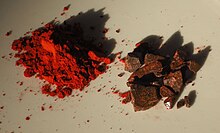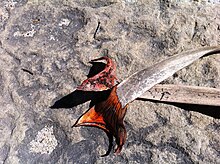Dragon's blood

Dragon's blood is a bright red resin which is obtained from different species of a number of distinct plant genera: Calamus spp. (previously Daemonorops) also including Calamus rotang, Croton, Dracaena and Pterocarpus. The red resin has been in continuous use since ancient times as varnish, medicine, incense, pigment, and dye.
Name and source[edit]

A great degree of confusion existed for the ancients in regard to the source and identity of dragon's blood. Some medieval encyclopedias claimed its source as the literal blood of elephants and dragons who had perished in mortal combat.[1][2] The resin of Dracaena species, "true" dragon's blood, and the very poisonous mineral cinnabar (mercury sulfide)[3] were often confused by the ancient Romans. In ancient China, little or no distinction was made among the types of dragon's blood from the different species. Both Dracaena and Calamus resins are still often marketed today as dragon's blood, with little or no distinction being made between the plant sources; however, the resin obtained from Calamus has become the most commonly sold type in modern times, often in the form of large balls of resin. Resins that come from different species and different continents have been given the name “dragon's blood,” but their purity, appearance, and chemical properties are highly varied.[4]
Voyagers to the Canary Islands in the 15th century obtained dragon's blood as dried garnet-red drops from Dracaena draco, a tree native to the Canary Islands and Morocco. The resin is exuded from its wounded trunk or branches. Dragon's blood is also obtained by the same method from the closely related Dracaena cinnabari, which is endemic to the island of Socotra. This resin was traded to ancient Europe via the Incense Road.
Dragon's blood resin is also produced from the rattan palms of the genus Calamus of the Indonesian islands and known there as jernang or djernang. It is gathered by breaking off the layer of red resin encasing the unripe fruit of the rattan. The collected resin is then rolled into solid balls before being sold.
The red latex of the Sangre de Drago (called Sangre de Grado in Peru), from any of seven species of Croton native to Peru, Bolivia, Ecuador and Brazil, has purported wound-healing and antioxidant properties, and has been used for centuries by native people. The species are:[5]
- Croton draconoides Muell. Arg., (wikispecies)
- Croton palanostigma Klotzsch, (wikispecies)
- Croton perpecosus Croiza, (wikispecies)
- Croton rimbachii Croizat, (wikispecies)
- Croton sampatik Muell. Arg., (wikispecies)
- Croton erythrochilus Muell. Arg., (wikispecies)
- Croton lechleri Muell. Arg., (wikispecies)
Visual characteristics[edit]
In his study of artists' pigments, the chemist George Field described dragon's blood as “a warm semi-transparent, rather dull, red colour, which is deepened by impure air, and darkened by light.”[6]
History and uses[edit]
This section needs additional citations for verification. (June 2023) |
The dragon's blood known to the ancient Romans was mostly collected from D. cinnabari, and is mentioned in the 1st century Periplus Maris Erythraei (xxx.10.17) as one of the products of Socotra. Socotra had been an important trading centre since at least the time of the Ptolemies. Dragon's blood was used as a dye, painting pigment, and medicine (respiratory and gastrointestinal problems) in the Mediterranean basin, and was held by early Greeks, Romans, and Arabs to have medicinal properties. Dioscorides and other early Greek writers described its medicinal uses.[7]

A notable occurrence of dragon's blood red in art is in Giotto's Pentecost. In this painting, it is believed that the pigment used in the orange-red flames over the Apostles' heads is dragon's blood.[8]
Locals on Socotra island use the Dracaena resin as a sort of cure-all,[citation needed] using it for such things as general wound healing, a coagulant (though this is ill-advised with commercial products, as the Calamus species acts as an anti-coagulant[9] and it is usually unknown what species the dragon's blood came from), curing diarrhea, lowering fevers, dysentery diseases, taken internally for ulcers in the mouth, throat, intestines and stomach, as well as an antiviral for respiratory viruses, stomach viruses and for skin disorders such as eczema. It was also used in medieval ritual magic and alchemy.
Dragon's blood of both Dracaena draco (commonly referred to as the Draconis Palm) and Dracaena cinnabari were used as a source of varnish for 18th century Italian violinmakers. There was also an 18th-century recipe for toothpaste that contained dragon's blood.
Dragon's blood from both Calamus were used for ceremonies in India. Sometimes Dracaena resin, but more often Calamus resin, was used in China as red varnish for wooden furniture. It was also used to colour the surface of writing paper for banners and posters, used especially for weddings and for Chinese New Year.
Dragon's blood incense is also occasionally sold as "red rock opium" to unsuspecting would-be drug buyers. It actually contains no opiates, and has only slight psychoactive effects, if any at all.[10]
Thaspine from the Dragon's Blood of the species Croton lechleri has possible use as a cancer drug.[11]
Today, dragon's blood from a South American plant can be bought in health food stores.[12]
According to Pliny the Elder, dragon's blood was used by artists in antiquity. Painters continued to use it in the creation of flesh tones during the 17th century. By the 19th century, publications on artists' materials indicate that it was most useful as a varnish, not as pigment for painting. In 1835, George Field stated that dragon's blood is “unsatisfactory for painting.” However, the pigment was used to prepare the color known as "Chinese orange."[13]
Today, dragon's blood has a variety of uses. Outside of it being a pigment in paintings and colors, it is still used as a varnish for violins, in photoengraving, as a medicine, as an incense resin, and as a body oil.[citation needed]
Safety[edit]
A study on oral toxicity of the DC resin methanol extract taken from the perennial tree Dracaena cinnabari was performed on female Sprague Dawley rats in February 2018. Acute and sub-acute oral toxicity tests found that the extract could be tolerated up to 2,000 mg/kg body weight.[14]
List of botanical sources[edit]

- Calamus rotang L.
- Calamus draco Willd. (synonyms include Daemonorops draco, D. rubra)
- Calamus didymophyllus Becc. Ridl. (synonyms include Daemonorops motleyi, D. didymophylla)
- Croton draconoides Müll. Arg.
- Croton draco Schltdl. & Cham.
- Croton lechleri Müll. Arg.
- Croton erythrochilus Müll. Arg.
- Croton palanostigma Klotzsch
- Croton perspeciosus Croizat
- Croton rimbachii Croizat
- Croton sampatik Müll. Arg.
- Croton urucurana Baill.
- Croton xalapensis Kunth
- Dracaena cinnabari Balf.f.
- Dracaena cochinchinensis hort. ex Baker
- Dracaena draco (L.) L.
- Pterocarpus officinalis Jacq.
See also[edit]
- Crofelemer, South American tree (Croton lechleri), unrelated to Dracaena and rattan palm (the generus Calamus)
Footnotes[edit]
- ^ De Hamel, Christopher (1992). Scribes and Illuminators. Medieval Craftsmen series. Toronto: University of Toronto Press. p. 62.
- ^ St. Clair, Kassia (2016). The Secret Lives of Colour. London: John Murray. p. 155. ISBN 9781473630819. OCLC 936144129.
- ^ "Safety data for mercuric sulphide". ox.ac.uk. Archived from the original on 2009-09-22. Retrieved 2009-02-15.
- ^ Gupta, Deepika; Bleakley, Bruce; Gupta, Rajinder K. (2008-02-12). "Dragon's blood: Botany, chemistry and therapeutic uses". Journal of Ethnopharmacology. 115 (3): 375. doi:10.1016/j.jep.2007.10.018. ISSN 0378-8741. PMID 18060708.
- ^ Meza, E. N., ed. (1999). Desarrollando nuestra diversidad biocultural: Sangre de Grado y el reto de su producción sustentable en el Perú. Lima: Universidad Nacional Mayor de San Marcos, Fondo Editorial. ISBN 978-9972910302.
- ^ Field, George (1835). Chromatography, Or, A Treatise on Colours and Pigments, and of Their Powers in Painting, &c. United Kingdom: Charles Tilt. p. 97. ISBN 978-1110185221.
- ^ Casson, L. (1989). The Periplus Maris Erythraei. Princeton Press. pp. 69, 168–170. ISBN 0-691-04060-5.
- ^ Bomford, David; Gordon, Dillian; Dunkerton, Jill; Roy, Ashok; Kirby, Jo (2011). The Italian Paintings Before 1400. London: National Gallery London. p. 71. ISBN 978-1-85709-482-4. OCLC 642214264.
- ^ Gibbs, A; Green, C; Doctor, VM (1983). "Isolation and anticoagulant properties of polysaccharides of Typha Augustata and Daemonorops species". Thromb. Res. 32 (2): 97–108. doi:10.1016/0049-3848(83)90021-X. PMID 6658717.
- ^ "Erowid Opiates Vault : "Red Rock Opium" Myth #1". Erowid.org. Retrieved 2011-01-28.
- ^ Fayad, W; Fryknäs, M; Brnjic, S; Olofsson, MH; Larsson, R; Linder, S (2009). "Identification of a novel topoisomerase inhibitor effective in cells overexpressing drug efflux transporters". PLOS ONE. 4 (10): e7238. Bibcode:2009PLoSO...4.7238F. doi:10.1371/journal.pone.0007238. PMC 2749935. PMID 19798419.
- ^ Lee, David (2007). Nature's Palette the Science of Plant Color. Chicago: The University of Chicago Press. p. 242. ISBN 9780226470528.
- ^ Eastaugh, Nicholas; Walsh, Valentine; Chaplin, Tracy; Siddal, Ruth (2004). Nature's Palette the Science of Plant Color. Oxford: Elsevier Butterworth-Heinemann. p. 143. ISBN 0-7506-57499.
- ^ Al-Afifi NA, Alabsi AM, Bakri MM, Ramanathan A (February 2018). "Acute and sub-acute oral toxicity of Dracaena cinnabari resin methanol extract in rats". BMC Complementary and Alternative Medicine. 18 (1): 50. doi:10.1186/s12906-018-2110-3. PMC 5800047. PMID 29402248.|
Further reading[edit]
- Langenheim, J. (2003). Plant Resins: Chemistry, Evolution, Ecology, and Ethnobotany. Timber Press. ISBN 978-0-88192-574-6.
- Schafer, E. H. (1963). The Golden Peaches of Samarkand: A study of T'ang Exotics. University of California Press. p. 211. ISBN 978-0520054622.
- Schoff, Wilfred H. (1995) [1912]. The Periplus of the Erythraean Sea. South Asia Books. ISBN 81-215-0699-9.
